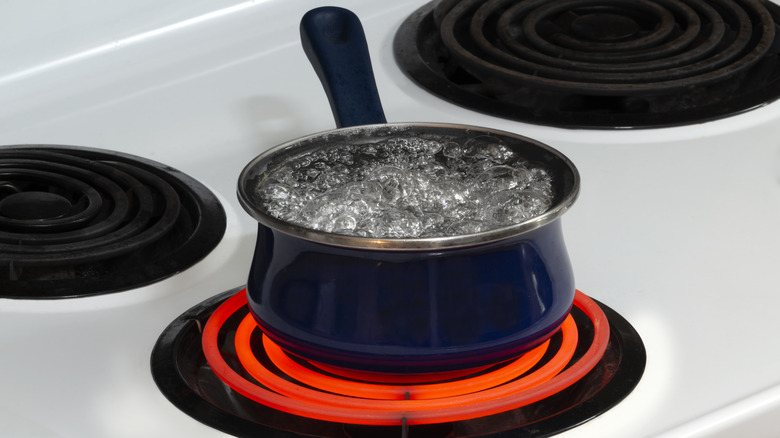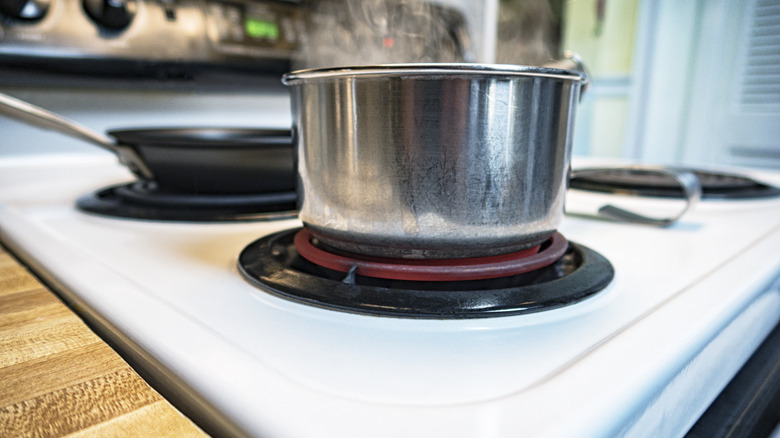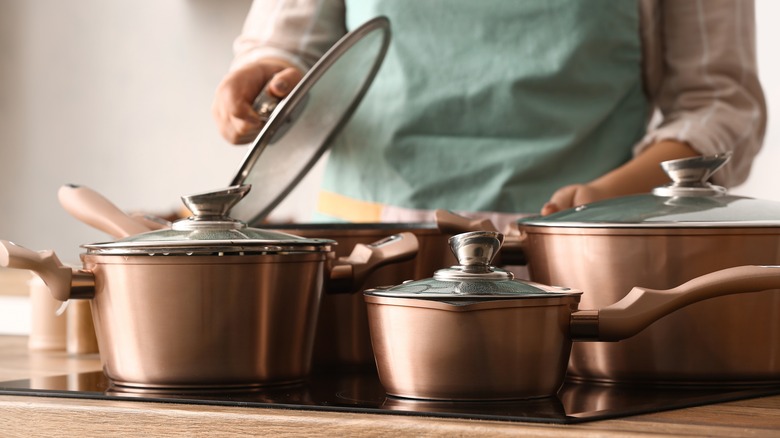The Electric Stove Top Mistake That Wastes Tons Of Energy
On the surface, stove top cooking seems straightforward. Put a pot or pan on the burner, turn a knob, add ingredients, and stir occasionally. However, with electric stove tops, there's a simple way to ensure you're cooking efficiently based on cookware and burner size. Not only will you save time (who doesn't want dinner to be done sooner?), but you'll also save energy, which is nothing to scoff at nowadays.
Everything seems to be getting more expensive — especially in the kitchen. Since 2020, overall food costs have gone up each year, with a 9.9% increase in 2022 alone (via USDA Economic Research Service). While eating at home is generally cheaper than dining out, cooking comes with its own costs: Energy. Unsurprisingly, those are increasing, too. Electricity prices rose more in 2022 than any other year recorded by the U.S. Energy Information Administration, and they aren't going down either. With about two-thirds of Americans preparing meals with electric appliances, there's nothing to lose by using them more efficiently.
Despite many home and professional chefs holding strong opinions about gas stoves, a cultural controversy as much as a culinary one, electric stove tops tend to be more efficient at heating food. But their strength in this department isn't infallible. While it might seem insignificant, using the wrong burner size is a small mistake responsible for a lot of wasted energy. By pairing cookware with burners that are similar in size, you'll be able to finish breakfast faster while saving money.
Use appropriately sized cookware for each electric burner
Have a favorite stove burner? It might be time to shake up your habits. The typical electric stove top features coil burners in two sizes, ranging from 6 to 12 inches in diameter. With a turn of the knob, electricity powers the metal coil until it becomes hot, which then transfers to cookware with contact, heating up its contents. However, the heating element's efficiency is influenced by the size of the pot or pan sitting on it; large cookware on a small burner won't heat as well as small cookware on a small burner.
Not only can this skew cook times and temperatures, potentially delaying the dinner you've been eagerly anticipating, but it also wastes energy — a lot of it. Putting a 6-inch pan on an 8-inch burner wastes over 40% of the produced heat (via American Council for an Energy-Efficient Economy). The slight 2-inch difference in surface area causes the heat from the uncovered coil to dissipate, warming the air instead of your food. The simplest solution to this inefficiency? Match the cookware size to the burner size.
It's also important to use undamaged pots and pans. If the cookware's surface area doesn't come into good contact with the burner, then the point is moot. Compared to a flat-bottom pan, cooking with a warped-bottom pan can use 50% more energy. Ironically, small burners can cause frying pans to warp, so using the right burner can extend the life of your cookware.
The best burners for common cooking tasks and any odd pans out
No matter what you're cooking, the burner you select can significantly impact how it turns out. After all, the best burner temperature for fluffy scrambled eggs won't be the same for steak. Larger burners produce more heat than smaller ones, so they're the best bet for searing meat, boiling water, and other tasks that need high heat. Since smaller burners generate less heat, they're ideal for dishes that cook slowly or must be kept warm as other food finishes up. Even if you're only simmering a simple tomato sauce, the big pot it's in will still receive the most even heating on a similarly sized burner rather than a small, less powerful one.
But what do you do if your cookware doesn't match the size of the burners on your stove top? It depends on what (and how much) you're cooking. Say you're frying an egg in a pan that's bigger than the smallest burner. If the food won't cover the entire surface area of the pan, you don't really need to worry about heating its entire bottom. In certain cases, it's easy enough to position the food where it's hottest. If the pan is too full to do this, it might be worth switching to a larger one — and a larger burner — to prevent crowding and ensure even cooking. By using the appropriately sized cookware, you'll be able to minimize wasted energy and eat sooner.


